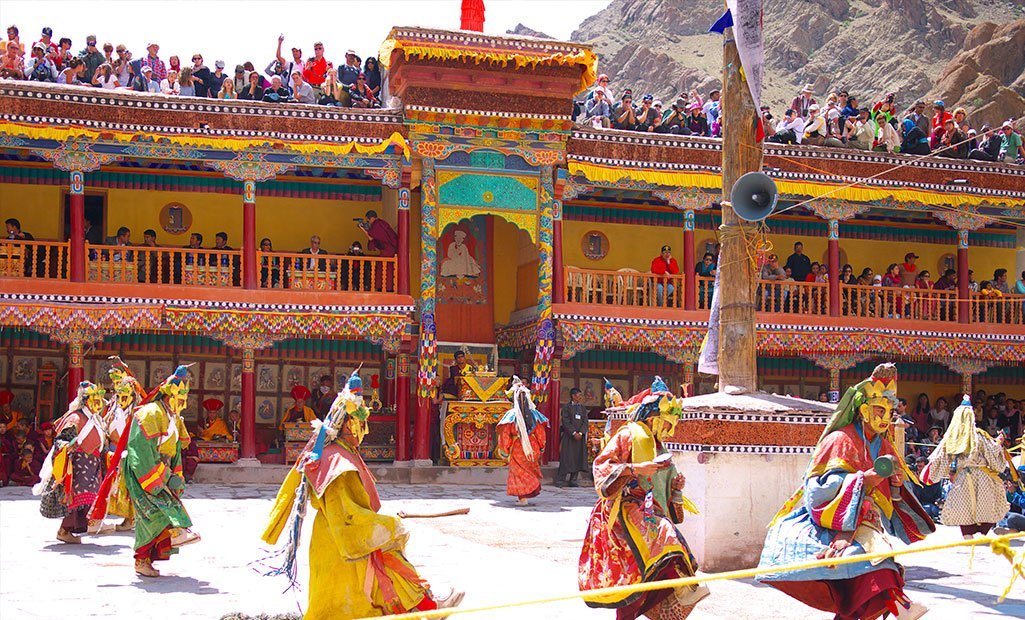Ladakh – a word which means “land of high passes”, is a region in the state of Jammu and Kashmir of Northern India sandwiched between the Karakoram mountain range to the north and the Himalayas to the south.
It is one of the most sparsely populated regions in India. Historically, the region included the Indus Valley, the remote Zanskar to the south, and Nubra valleys to the north over Khardung La in the Ladakh mountain range. Ladakh borders Tibet to the east, the Lahul and Spiti to the south, Kashmir to the west, and Central Asia to the north.
Ladakh is renowned for its remote mountain beauty and Buddhist culture which was established as early as the 2nd century. This has given rise to the appellation “Little Tibet”, as it has strongly been influenced by the culture of Tibet.
Ladakh is India’s highest plateau (much of it being over 3,000 m), spanning the Himalayan and Karakoram mountain ranges and the upper Indus River valley. Historic Ladakh consists of a number of distinct areas, including the fairly populous main Indus valley, the more remote Zanskar (in the south) and Nubra valleys (to the north over Khardung La ), the almost deserted Aksai Chin (under Chinese rule) and Kargil and Suru Valley areas in the west (Kargil being the second most important town in Ladakh). Before partition, Baltistan (now under Pakistani rule) was one of the districts of Ladakh. Skardu was the winter capital of Ladakh while Leh was the summer capital.
The mountain ranges in this region were formed over a period of 45 million years by the folding of the Indian plate into the stationary landmass of Asia. The drift continues and causing frequent earthquakes in the Himalayan region.. The peaks in the Ladakh range are at a medium altitude close to the Zoji-la (5,000-5,500 metres, 16,000 – 18,050 ft), and increase towards south-east, reaching a climax in the twin summits of Nun-Kun (7000 m, 23,000 ft).
Ladakh has always been “Crossroads of High Asia” and has server as a conveyor channel of diverse cultural ideologies between the major cultural areas lying beyond its barrier.
Leh was an important trade centre of Central Asia from time immemorial and was a meeting place of the people of different nationalities. The region witnessed the ups and downs of “Great Game” in the 19th Century
The Suru and Zanskar valleys form a great trough enclosed by the Himalayas and the Zanskar range. Rangdum is the last inhabited region in the Suru valley. From Rangdum the valley rises to 4,400 metres (14,436 ft) at Pensi-la, the gateway into Zanskar. Kargil, the only town in the Suru valley, was an important staging post on the routes of the trade caravans before 1947, being more or less equidistant, at about 230 kilometres from Srinagar, Leh, Skardu, and Padum.
The Khardung-la pass, believed to be the highest motorable pass in the world at 5,602 m or 18,380 ft)
The Zanskar valley lies in the troughs of the Stod and the Lungnak rivers. The region suffers heavy snowfall, and the Pensi-la opens only in June, and is blocked again in mid-October. The Indus River is the backbone of Ladakh — all major towns historically and currently, Shey, Leh, Basgo, and Tingmosgang, are situated close to the river.
The Ladakh range has no major peaks; its average height is a little less than 6,000 metres (19,700 ft), and few of its passes are less than 5,000 metres (16,400 ft). The Pang-gong range runs parallel to the Ladakh range about 100 km northwest from Chushul, along the southern shore of the Pang-gong Lake Its highest range is 6,700 metres (22,000 ft), and the northern slopes are heavily glaciated.
The region comprising the valley of Shayok and Nubra rivers is known as Nubra. The Karakoram range in Ladakh is not as mighty as in Baltistan. North of the Karakoram lies the Kunlun. Thus, between Leh and eastern Central Asia, there is a triple barrier — Ladakh range, Karakoram range, and Kunlun. Nevertheless, a major trade route was established between Leh and Yarkand.




